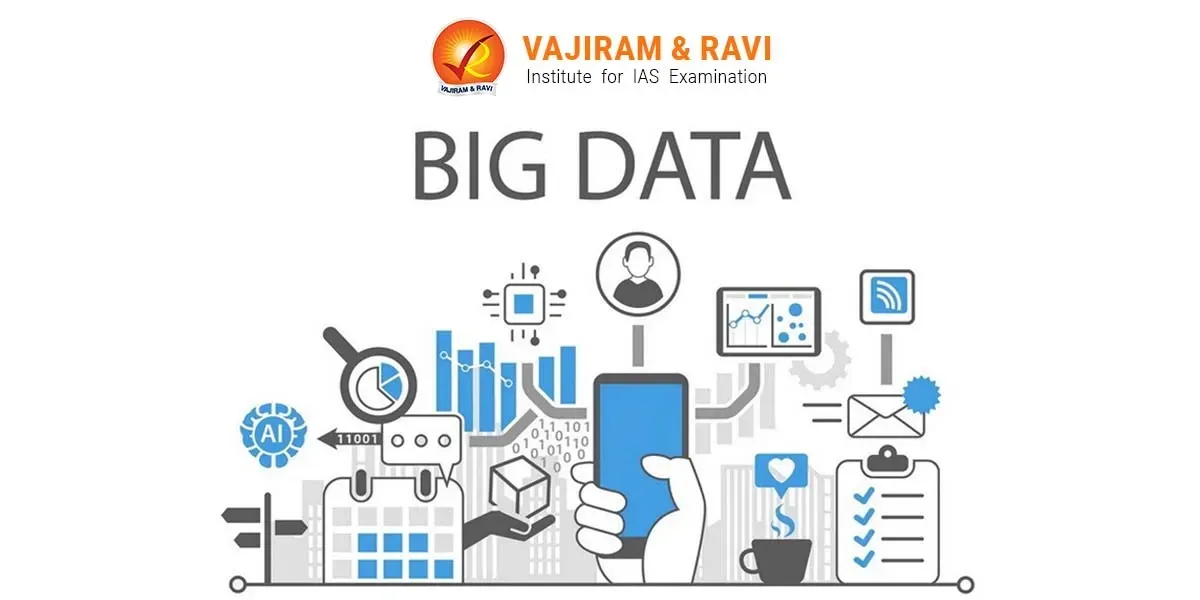In the modern world, where data is the new oil, Big Data can be considered a system that processes crude oil into usable fuel. It essentially means a vast collection of data, encompassing - structured, semi-structured, or unstructured types. It is not just about the sheer volume of data; it also encompasses the entire cycle of collecting, storing, and analysing this data. The sheer size of this data makes it challenging for organisations to handle and analyse it with conventional database and software methods.
The rise of big data has become a key aspect of the technological revolution, embodying an invaluable asset for governments and organisations across the globe.
What is Big Data?
Big Data involves collecting and analysing vast amounts of information to uncover patterns, trends, and insights, often requiring advanced technology due to its size and complexity. There are 5Vs that drive big data, such as:
- Volume: It denotes the quantity of data accumulated, encompassing both structured and unstructured formats.
- Velocity: It indicates the speed at which new data is generated and collected.
- Variety: It describes the diverse range of data types and formats that are gathered for analysis.
- Value: It highlights the practical worth or benefit of the data acquired.
- Veracity: Big Data pertains to the reliability and accuracy of data originating from various channels.
Evolution of Big Data Analytics
- Phases of development: The Big Data Framework organisation identifies three phases of Big Data evolution:
- Phase 1.0: Focused on data storage and analytics as an extension of database management systems.
- Phase 2.0: Evolved with Web 2.0 to include solutions for extracting information from varied data formats.
- Phase 3.0: The advent of smartphones, IoT, and wearable technology.
Need for Big Data Analytics
The findings of Big data analytics can lead to more informed and strategic decisions. Other reasons include:
- Customer acquisition & retention: Using consumer data enhances marketing, leading to higher satisfaction through personalised experiences like those offered by Amazon, Netflix, and Spotify, thus boosting loyalty.
- Targeted advertising: Data from past interactions and browsing habits enable the creation of effective, personalised ad campaigns tailored to individual users and broader audiences.
- Product development: Big data insights guide product creation and improvement, ensuring decisions align with customer preferences and market demand.
- Price optimization: Retailers leverage varied data sources for pricing strategies to maximise profits.
Working of Big Data Analytics
The Big data procedure includes several stages:
- Gathering data: It is amassed from a multitude of sources, including social networks, sensory devices, business transactions, and consumer feedback.
- Storing data: This data is subsequently stored using advanced storage systems designed to facilitate easy retrieval and analysis, accommodating the sheer volume of data.
- Processing data: Before analysis, the data undergoes processing to eliminate inaccuracies or inconsistencies, converting it into an analytically amenable format.
- Analysing data: Utilising statistical techniques and machine learning algorithms, the processed data is scrutinised to detect patterns, correlations, and emerging trends.
- Visualising data: Finally, the analytical results are depicted through graphs, charts, and interactive dashboards, providing decision-makers with clear, actionable insights.

Significance of Big Data Analytics
- Informed decision-making: Big data analytics provide deep insights that help organisations make data-driven decisions, leading to improved outcomes.
- Predictive analysis: By identifying trends and patterns, It enables predictive analytics, which can forecast future events and behaviours.
- Customer insights: Businesses can better understand customer preferences and behaviours, allowing for targeted marketing and personalised customer experiences.
- Operational efficiency: Analysing large data sets can help streamline operations, reduce costs, and increase efficiency across various business processes.
- Innovation and development: It can drive innovation, influencing new products and service development by identifying needs and opportunities.
- Risk management: Organisations can use it to identify potential risks and develop strategies to mitigate them, enhancing security and compliance.
- Competitive advantage: Access to and the ability to analyse big data can provide a competitive edge by uncovering opportunities and optimising strategies.
Applications of Big Data Analytics

As data has become ubiquitous in our daily life, its analytical understanding too become important. It has diverse applications mentioned in the table below:
| Area | Applications |
| Governance |
- Utility management: Power distribution companies utilise last-mile data analytics to reduce their Aggregate Technical and commercial losses. - Law enforcement and security:
- Education enhancement: Leveraging it to raise the standard and effectiveness of educational systems. - Risk mitigation: Using predictive analytics to understand and lessen the impact of natural and man-made disasters. |
| Economy |
- Insurance sector: Utilising it to refine customer service and uphold clients' claims rights. - Banking sector: Leveraging big it for efficient handling of vast financial datasets. - Economic analysis: Capturing production and price statistics to compute accurate Gross Domestic Product figures. - Risk management: Applying big data to predict risks and reduce financial losses. - Taxation: Utilising Project Insight to track down tax evaders. - Corporate regulation: Employing it to identify and deregister numerous inactive shell companies. -Anti-money laundering: To detect and prevent money laundering and disrupt terrorism financing by pinpointing and scrutinising the transactions in known safe-havens. |
| Healthcare |
- Predictive analytics: Foreseeing patient health outcomes and hospital admissions. - Personalised medicine: Tailoring treatments and medications to individual genetic profiles. -Disease surveillance: Tracking and predicting disease outbreaks and epidemics. -Clinical trials: Optimising recruitment and monitoring of clinical trial processes. -Patient monitoring: Continuously tracking patient vitals through connected devices. -Healthcare management: Enhancing resource allocation and operational efficiency in hospitals. |
| Agriculture |
- Precision farming: Utilising data to enhance crop yield and resource efficiency by tailoring farming practices to local conditions. -Crop disease prediction: Analysing weather and soil data to predict disease outbreaks and take preventive actions. -Supply chain optimisation: Streamlining the agricultural supply chain by predicting demand and managing inventory through data analysis. -Livestock monitoring: Tracking health and productivity of livestock using data collected from sensors. - Climate impact analysis: Studying big data patterns to understand the impact of climate change on agriculture and adapting farming practices accordingly. |
| Digital Space |
-Telecommunications: Bridging rural areas with mainstream networks through data-driven infrastructure expansion. - Social Media: Leveraging user data for precise content delivery and advertising on social platforms. - Artificial Intelligence: Facilitating the management of home appliances through AI and data analysis. - Wearable Technology: Utilising data from wearables to enhance personal performance in professional settings, athletics, and daily life. |
| Defence |
- Threat analysis: Identifying and assessing security threats through comprehensive data analysis. - Mission planning: Enhancing strategic decision-making and operational planning with data-driven insights. - Cybersecurity: Fortifying defence networks against cyber attacks with advanced data analytics. -Weapon system development: Guiding the development of advanced weapon systems through simulation and data analysis. -Combat simulation and training: Enhancing training programs with realistic data-driven combat simulations. |
| Space Technology |
- Satellite data analysis: Processing vast amounts of satellite imagery to monitor environmental changes, urban development, and natural disasters. -Mission trajectory optimisation: Using data to optimise flight paths and reduce fuel consumption for spacecraft. -Space traffic management: Analysing orbital data to track space debris and avoid collisions for operational satellites. - Exoplanet exploration: Applying data analytics to identify and study potentially habitable planets outside our solar system. -Life support system analysis: Monitoring and adapting life support systems on manned missions through real-time data. |
Big Data vs IOT
The Internet of Things (IoT) and Big Data are two distinct but increasingly interconnected technological domains. Their differentiating applications include:
| IOT | Big Data |
| Smart home devices: Thermostats, lighting systems, security cameras, and other home appliances connected to the internet for remote monitoring and control. | Business analytics: Analysing large volumes of data to uncover patterns, trends, and insights for business decisions. |
| Wearable health monitors: Devices like fitness trackers and smartwatches that monitor vital signs and physical activity. | Healthcare: Managing patient records, analysing trends in disease spread, and research in genomics. |
| Industrial automation: Sensors and devices in manufacturing and production lines for monitoring and optimising operations. | Financial services: Fraud detection, risk management, and algorithmic trading based on the analysis of large datasets. |
| Agriculture: IoT sensors used for soil moisture monitoring, climate control in greenhouses, and livestock tracking. | Retail: Personalised marketing, customer behaviour analytics, and supply chain optimization. |
| Smart cities: IoT devices for traffic management, waste management, and utility services. | Social Media Analytics: Analysing vast amounts of user-generated content for trends, sentiment analysis, and targeted advertising. |
| Automotive: Connected vehicles with features like predictive maintenance, GPS tracking, and autonomous driving. | Scientific research: Handling large datasets in fields like climatology, physics, and biology for research purposes. |
India’s Initiatives in Big Data Analytics
With a population of around 1.4 billion, Big Data holds a significant position in the Indian context. In this regard, key initiatives of the Government of India in the realm of big data are:
National Data & Analytics Platform
- Inception of NDAP: In May 2022, the NITI Aayog initiated the National Data and Analytics Platform (NDAP) in partnership with various government ministries and states.
- NDAP was conceived to overcome current barriers to government data usage.
- Functions:
- NDAP provides access to government datasets in machine-readable formats, featuring an intuitive interface and advanced analytics capabilities.
- The platform employs advanced techniques to interlink varied government datasets, facilitating multi-type data utilisation.
- NDAP caters to a wide range of users, including government officials, academics, journalists, and members of civil society.
- Status: As of February 2023, NDAP has compiled 885 datasets from 46 Ministries, covering 15 different sectors.
Big Data Management Policy
- Initiation: Initiated by the Comptroller and Auditor General (CAG)
- Objective: To audit substantial volumes of data produced within the public sector across states and union territories represents a commendable beginning.
- Digital Auditing: Transitioning to digital auditing for comprehensive transaction analysis.
- Data Analytics: Integrating various data forms to discover insights and patterns.
National Data Warehouse on Official Statistics
- Initiation: The Ministry of Statistics and Programme Implementation is establishing a National Data Warehouse.
- It will encompass information regarding education, employment history, financial activities, and health documentation.
- Need: Several challenges it could address:
- Data sharing issues between government agencies
- Unavailability of data in digital format or machine-readable format.
- Lack of data standardisation.
- Lack of regular updates.
- Lack of accuracy and completeness.
- Significance: The production will have several advantages
- Central data repository: A data warehouse acts as a central hub for the data collected from various business systems within an organisation.
- Data consolidation: The data warehouse will aggregate data from different government agencies and departments.
- Data preparation: Before being made available, data will be consolidated, cleansed, harmonised, and enriched within the warehouse.
- Demographic and economic information: Data stored will include personal details such as name and address, as well as educational and income levels.
Challenges with Big Data Analytics
Despite several advantages associated with Big Data Analytics, there are several challenges associated:
- Privacy concerns: Analytics can infringe on privacy through issues like data privacy and the principle of net neutrality.
- Enhancing data security: Incidents of Aadhaar data breaches have highlighted the need for the government to fortify the security of digital data from citizens.
- Technical hurdles: It faces technical challenges such as inadequate infrastructure for data handling, storage constraints, and difficulties with scalability and real-time processing.
- Governance issues: Effective use of Big Data in government policy making requires an adaptable and dynamic approach, with continuous feedback evaluation and policy adjustment.
- Data ownership and monetisation: Determining who owns data, especially when it is generated by users but collected by platforms, raises questions about rights and monetisation.
- Bias and discrimination: Algorithms used in Big Data analytics can perpetuate existing biases if they're not carefully designed and monitored, leading to discrimination.
- Access inequality: There is a concern that Big Data may widen the gap between those who can analyse and leverage it and those who do not.
- Over-reliance on data-driven decisions: There's a risk of becoming too reliant on data-driven decision-making, potentially overlooking qualitative factors and human judgement.
Way Forward
Big Data analytics is the future of data usage, it can make data work for the advantage of common man and therefore several safeguards can be taken to ensure its effective utilisation such as:
- Addressing data privacy ethics: Tackle ethical concerns surrounding data privacy.
- Best practices in data protection: Update data protection laws to reflect global best practices.
- Cybersecurity enhancement: Bolster cybersecurity to protect vast quantities of digital data.
- Economic impact of Big Data and blockchain: Explore the transformative potential of integrating big data with blockchain technology. It will improve traceability and provide real-time data analysis with utmost accuracy.
- Infrastructure for data analysis: Develop robust data centres to manage and sift through massive data volumes.
- Big Data Governance: Leverage modern data sources for improved governance, especially in areas like India with historically limited policy implementation.
Last updated on December, 2025
→ Check out the latest UPSC Syllabus 2026 here.
→ Join Vajiram & Ravi’s Interview Guidance Programme for expert help to crack your final UPSC stage.
→ UPSC Mains Result 2025 is now out.
→ UPSC Notification 2026 is scheduled to be released on January 14, 2026.
→ UPSC Calendar 2026 is released on 15th May, 2025.
→ UPSC Prelims 2026 will be conducted on 24th May, 2026 & UPSC Mains 2026 will be conducted on 21st August 2026.
→ The UPSC Selection Process is of 3 stages-Prelims, Mains and Interview.
→ UPSC Result 2024 is released with latest UPSC Marksheet 2024. Check Now!
→ UPSC Toppers List 2024 is released now. Shakti Dubey is UPSC AIR 1 2024 Topper.
→ Also check Best IAS Coaching in Delhi

















